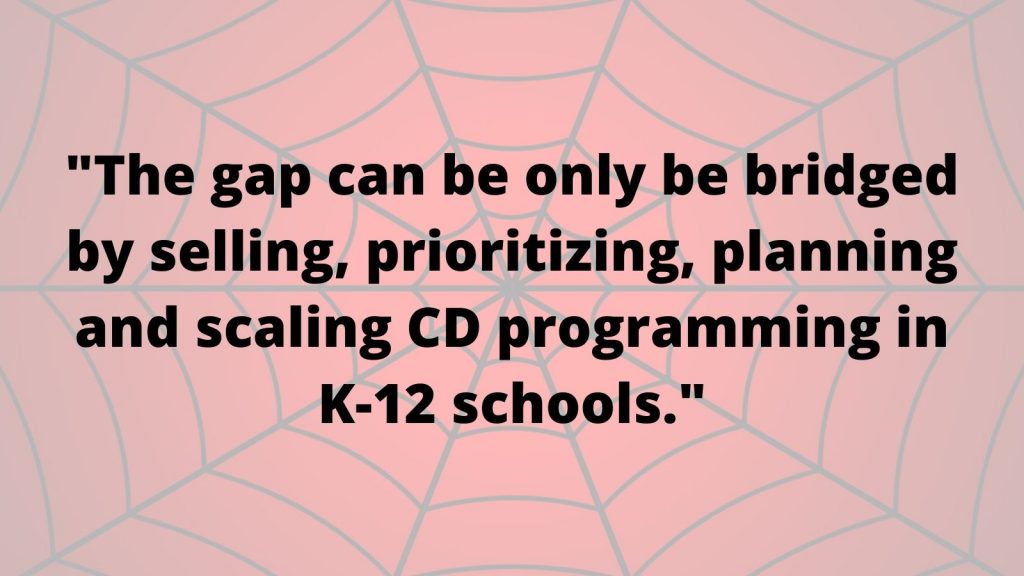
Making career development ‘stick’ in K-12
The career development gap in schools can only be bridged by prioritizing and scaling programming
Adriano Magnifico
 I grew up with superheroes.
I grew up with superheroes.
I loved their superpowers – Superman leaping tall buildings in a single bound or the Torch igniting into a flaming comet.
I always had a soft spot for Spiderman, who could spew silk from his wrists and stick to the sides of buildings. He constantly helped those in distress but struggled to gain the respect of the public.
It reminds me of the typical career development (CD) practitioner.
CD has a respect problem in schools, a notion echoed by Deirdre Pickerell, Dean of Student Success at Yorkville University, who noted how hard it to get career development to “stick” (2020) in the hearts and minds of leaders.
CD’s transformative power must become higher profile – by integrating a Spiderman-like “stickiness” into K-12 programs.
The problem: A career development gap
Career development has long been a part of high school, but its delivery is intermittent and scattered. Program leads, usually guidance counsellors, are often besieged with mental health issues, family engagement, academic recovery programming, at-risk students and graduation credits. Schools laud graduation rates far more than post-high school planning initiatives.
Read more on CareerWise
Helping students connect the dots in their career development
COVID-19 reveals opportunities and challenges in online learning
Three people your student should meet before graduating high school
The problem is a sizeable gap between research (RBC, 2018, Statistics Canada, 2020, The Canadian Chamber of Commerce, 2014) purporting that career development is “central to learning across K-12” (CMEC, 2017) and the implementation of school plans that treat CD as a bonus activity available to students when time permits.
The gap can be only be bridged by selling, prioritizing, planning and scaling CD programming in K-12 schools. The challenge is getting leaders and school teams on board.
But it can be done.
Bridging the CD gap
For 25 years, I have worked to bridge this gap in schools by adopting a “blue sky” perspective of the larger mission. These are my key action steps to build a school career development program that sticks:
- Talk to the leaders. The CD gap will never be properly tackled until practitioners sell career development to school administrations and then take time in staff meetings to stimulate discussion about how career development can supercharge any classroom subject. Without the school administration identifying career development as a priority, any effort, while worthy, will ultimately miss its larger mark.
- Find the CD champions. Teacher-champions exist in every school who can spread the mission and build a collaborative interschool framework. I run a Career and Innovation Group in Louis Riel School division that meets regularly to discuss our CD initiatives and plans.
- Establish a foundation. Is there a 24/7 CD tool that every student, parent and teacher can access? Scaling career development in a building is difficult without one. Our division uses an online tool called myBlueprint, but there are other options. Every Grade 7-12 student has an account and access to self-assessment tools, school credits, occupations, goal setting, e-portfolios and scholarships.
- Integrate CD into courses. Some provinces mandate career courses. Manitoba offers optional career electives. These are useful, but they tend to compartmentalize career development. A stronger strategy is to integrate career development into everyday courses such as math, English and biology, and to get bigger buy-in from all subject teachers in schools.
- Involve parents. Research continuously shows that parents are the No. 1 influence when students decide on post-high school paths. Connecting with parents on CD initiatives in school is essential to having robust conversations about future pathways.
- Collect the dots; connect the dots. School and community do a great job of helping students collect dots – academic courses, clubs, sports, dancing, volunteer work, part-time jobs, etc. – but they do a poor job of helping students connect their dots, which is the key to effective career development. In Louis Riel School Division, we’ve created the LEAN Career Design Canvas, a tool that enables students to connect the dots of their experiences and to prepare for a career path that will last a lifetime. I share the Canvas with any practitioner who wants to try it out; it’s been iterated in 23 cities in and outside Canada.
- Build networks. Teach students the art of networking and model how to build professional and supportive networks. While telling students “to get out there” and connect with professionals may seem like a reasonable expectation, it’s really not. Without school networks of community professionals who offer internships, job shadows, volunteer experiences and mentorships, students will have no idea how to connect with employers or volunteer organizations. Most high school students need training, nudging and places to go.
- Create extra options. Offer more to students who want more. In partnership with RBC Future Launch, we’ve created the LRSD Skills Credential, an optional intensive career management program for Grade 11 and 12 students who complete career management workshops in financial literacy, labour market information, personal branding, ethics, problem-solving, project management and networking. Seventy-one LRSD students completed the Credential Program in 2019-2020; over 100 are in the pipeline for next year.
- Go online. COVID-19 has forced us to convert career development processes into fillable PDFs, one-on-one video chats and group video-conferencing. During the pandemic, 60 students presented their LEAN Career Design Canvases via TEAMS videoconferencing. The online canvas experience worked well; online tools will likely augment teacher-student engagements in the future.
- Build inclusivity. CD programming needs to appeal to the wide range of students in every school. For example, how does career programming connect with newcomer, Indigenous and LGBTQ2+ students? The Circle of Courage (Brendtro, 2009) has been an effective philosophy in Louis Riel School Division’s mission to build a culture of inclusivity.
Plan and pitch large
Currently, career development is too dependent on the will and persistence of a dedicated few working in the trenches with a minority of students. To bridge the career development gap that permeates K-12 schools, we need to build collaborative networks, pitch research and effective practice to school decision-makers and create inclusive plans that bring systemic CD into classrooms
Scaling career development programming that “sticks” to students’ lives can be transformational – they will not only collect the dots of their experiences, but also engage in thoughtful reflection that connects their dots in ways to help them see their best selves and future pathways. We can’t wait for a radioactive spider to make this happen.
Adriano Magnifico is your friendly neighbourhood Career and Entrepreneurship Consultant in the Louis Riel School Division in Winnipeg.
References
Brendtro, Larry K. Brokenleg, Van Bockern Steve. (revised edition 2009). Reclaiming Youth at Risk: Our Hope for the Future. Bloomington IN: Solution Tree Press.
Council of Ministers of Education, Canada Research & Publications. (n.d.). (2017). Retrieved from cmec.ca/9/Publication.html?cat=2
Pickerel, Deirdre, CERIC: Why Career Development Matters. Retrieved July 13, 2020, from https://ceric.ca/why-career-development-matters/
RBC. (March 2018). Humans Wanted. Retrieved from rbc.com/dms/enterprise/futurelaunch/_assets-custom/pdf/RBC-Future-Skills-Report-FINAL-Singles.pdf
Statistics Canada. (June 2020). “Through the Looking Glass: Assessing Skills Measures Using 21st Century Technologies.” LMI Insights. Issue No. 32. Retrieved from lmic-cimt.ca/wp-content/uploads/2020/06/LMI-Insight-Report-no-32-3.pdf
The Canadian Chamber of Commerce. (October 2014). A Battle We Can’t Afford to Lose: Getting Young Canadians from Education to Employment. Retrieved from chamber.ca/media/blog/141014-a-battle-we-cant-afford-to-lose-getting-young-canadians-from-education-to-employment/

